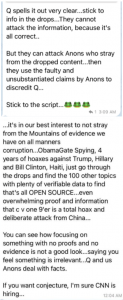 |
| QAnon sticker available from Amazon |
John F. Kennedy Jr. is dead and has been dead for some time. In July 1999, the small plane he was traveling in crashed off the coast of Martha’s Vineyard, killing him and two others. The bodies of Kennedy and his fellow passengers were found five days later in the Atlantic Ocean. This is the version of events most people know to be true. But, in the world of QAnon, things happened a bit differently: JFK Jr. survived an attempt on his life by the so-called “Deep State” and will soon return to exact revenge and help Donald Trump fight back against a globally active cabal of satanic pedophile elites that’s responsible for all the evil in the world.
The QAnon worldview is particularly prone to these sorts of predictions, and many adherents eagerly anticipate earth-shattering future events that will completely change the world, from “the Storm” (a near future apocalyptic realization when members of this evil cabal will be arrested) to the “Great Awakening” (a time when the general population will come to realize that they’ve been lied to for decades). Years of research into millennial movements and how they survive the often-inevitable failures of these prophetic pronouncements make clear that most movements, as we outline below, can survive these failures as long as certain conditions are in place. QAnon is no different.
The fact that JFK Jr. didn’t come back on Saturday October 17th at a Trump rally, is only one of many QAnon “prophecies” that haven’t come to fruition: Hillary Clinton has not been arrested, high profile elites have not been killed or sent to Guantanamo Bay, the hundred thousand sealed indictments were not released, and the promised Golden Age has not been delivered. And yet, the movement continues.
Surviving the failure of prophecy
Many researchers read these stories and point to a classic work by social psychologists Leon Festinger, Henry Riecken, and Stanley Schachter published in 1956: When Prophecy Fails. In the book, Festinger and his colleagues provide readers with an account of a small religious group they call “the Seekers,” whose leader, Marion Keech (a pseudonym), predicted the destruction of the entire United States in a great flood on December 21, 1955.
The Seekers, though, would be saved from this destruction by aliens who were communicating with Keech telepathically. On December 21, as midnight came and went with no spacecraft, many of the members wept and sat in disbelief. Then Keech received a message from the aliens: the apocalypse had been called off. As Festinger and colleagues write, “This little group, sitting all night long, has spread so much goodness and light that the God of the Universe spared the Earth from destruction.”
This final message was just what the group needed. While common sense may suggest that in the face of such an obvious prophetic failure, the group would have crumbled and the leader abandoned and ridiculed, this is not what happened. The final message communicated to Keech convinced the Seekers that all their work was not in vain; rather, it was precisely their preparations and commitment that saved humankind from cataclysm.
From this case study of the Seekers, Festinger developed what he called the theory of cognitive dissonance. Put simply, the theory asserts that people are uncomfortable holding inconsistent beliefs and ideas at the same time and are driven to reduce this discomfort. It should be noted that Festinger is not stating that reducing this discomfort is a preference. It isn’t something we wish to be the case; it’s a drive that will happen. As Joel Cooper put it, “people do not just prefer eating over starving; we are driven to eat.”
One of the things that the Seekers did after December 21 was also something counter-intuitive: they began to proselytize. Once the initial cognitive dissonance had been reduced by the idea that their actions had saved the world, they sought to solidify this new sense of consistency by seeking validation from the outside world.
When Prophecy Fails has faced some criticism for its methodology, but as Lorne Dawson points out, “on the whole the record shows that Festinger et al. were right to predict that many groups will survive the failure of prophecy. Why they survive is another matter. The reasons are much more complicated than When Prophecy Fails implies.” Festinger and his colleagues placed a lot of emphasis on proselytization as a key mechanism by which cognitive dissonance is reduced following prophetic failure. But research over the last several decades has added at least two more strategies: rationalization and reaffirmation.
Rationalization is now seen by researchers as the most important factor in whether a group survives prophetic failure. Groups can do this in at least four ways:
- Spiritualization: the group states that what was initially thought of as a visible, real-world occurrence did happen, but it was something that took place in the spiritual realm.
- Test of Faith: the group states that the prophecy was never going to happen, but is in fact a test of faith: a way for the “divine” to weed out true believers from those unworthy.
- Human Error: the group argues that it’s not the case that the prophecy was wrong, but that followers had read the signs incorrectly.
- Blame others: the group argues that they themselves never stated that the prophecy was going to happen, but that this was how outsiders interpreted their statements.
The third strategy—reaffirmation—is also one used by several groups discussed in previous research. In this approach, the group brushes aside the failure of prophecy and reaffirms the value of the group, the benefits of membership, and doubles down on the importance of their journey on the path of truth.
According to Lorne Dawson, the body of research on failure of prophecy notes that these three strategies are most successful when at least six conditions are present:
- In-group social support: the need to move on beyond the failure of prophecy is valiantly supported by others in the group.
- Decisive leadership: the leader does not “pause in confusion in the face of failure” but provides a confident and coordinated path forward.
- Sophistication of ideology: the prophecy is robust enough that the failure of one prophecy does not dismantle the entire edifice.
- Vagueness of prophecy: the predictions are vague enough to be rationalized away.
- Ritual framing: rituals are used to not only rationalize the failure but also purify the believers and reaffirm the value of the group.
- Organizational factors: different kinds of organizations or networks will be impacted differently by prophetic failure.
Below, we use the JFK Jr. case study to elucidate how QAnon followers have dealt with this failure of prophecy and point out that similar mechanics may be deployed by followers as other anticipated events in the future similarly fail. These insights will also be important for understanding how followers react to the potential electoral defeat of President Donald Trump, whom they consider to be a savior in the White House.
When JFK Jr. didn’t come back

Screenshot of Qdrop 1082, from the 8kun board where “Q” posts (the string of numbers are Q’s previous messages he is replying to) , hinting at a link between JFK Jr.’s plane crash in 1999 and Hillary Clinton’s run for Senate in 2000.
In 2018, QAnon adherents became convinced that Q, whose identity remains a mystery, was JFK Jr. This conspiracy theory began in April 2018 following Qdrop 1082 [image left], which is a reference to the Clinton body count conspiracy. This was then followed by another Qdrop containing a 1956 memo from the CIA’s public website. The CIA document had nothing to do with the Kennedys but contained a reference to “guided missiles.” For QAnon adherents, this was a hint from “Q” that JFK Jr’s plane was shot down with a guided missile to make way for Hillary Clinton’s political career, which started with a U.S. Senate run the year after the plane crash.
While this theory makes no logical sense, considering JFK Jr. was not a politician and never seriously considered becoming one, for QAnon adherents the Clintons and the ‘Deep State’ considered him a great enough threat that he was worth killing to make way for Hillary Clinton’s political career.

Screenshot of Qdrop 1697, from a Qdrop aggregator Where “Q” repudiates “R.”
The JFK Jr. conspiracy theory picked up steam in July 2018, during Q’s first long lull in posting. Mike Rains, who hosts the Adventures in HellwQrld podcast, told us that in the 20-day gap between Q posts, “an Anon who called themselves R took up the slack of posting about the great struggle between the Patriots and the Deep State. R made it clear that JFK Jr. was working with Trump to defeat the Deep State.” Q never engaged R on these claims, but when Q engaged in an 8Chan Q&A on July 25, 2018, they flatly denied that JFK Jr. was alive [image right].
According to Rains, this caused a lot of division in the QAnon community. The influential QAnon documentary, “The Fall of the Cabal” even ends with the claim that JFK Jr. is still alive, and that Q is merely using disinformation as a tool to protect him. Although two more Qdrops have appeared insisting that Q is not JFK Jr. and that JFK Jr. is dead, it’s had little impact on some QAnon adherents.
So why has this conspiracy stuck with QAnon adherents who usually hold Q’s word as gospel? Travis View, conspiracy theory researcher and co-host of the QAnon Anonymous podcast, told us:
“The belief that JFK Jr. is alive and will reveal himself soon is typically an extension of the belief that his father President Kennedy was assassinated by the deep state. This is seen in the claims from some QAnon followers that JFK Jr. is returning to avenge his father’s death. QAnon promises followers ultimate justice for those who have been harmed by the secret puppet masters of conspiracy theory lore. Those who believe that JFK Jr. lives simply assume that this promise extends to the tragic and traumatic deaths of JFK Jr and JFK. On top of that, these QAnon followers seem irresistibly drawn to the classic trope of a son reappearing to avenge his father’s death.”
In QAnon Telegram chats, after JFK Jr. did not return as predicted on October 17, 2020, the response was varied, but largely fell into the “human error” and “blame others” categories discussed above.
QAnon adherents stated that the JFK Jr. conspiracy theory was a deep state plot that was put in motion to discredit QAnon and the work they’re doing. As one post noted:
“Anons have gone way off base and they’re using it to make us look stupid. I personally prefer to stick with 3 years worth of hard evidence of government corruption and malfeasance on every level…things we CAN prove.”
Another post made a similar point, noting:
“Q spells it out very clear…stick to info in the drops…They cannot attack the information, because it’s all correct.. But they can attack Anons who stray from the dropped content…then they use the faulty and unsubstantiated claims by Anons to discredit Q…”

Screenshots from QAnon Telegram Channels reacting to the failure of the JFK Jr. prophecy.
In other words, adherents argued that some followers had strayed from the path of truth and were now dabbling in ideas that were hurting the cause. This argument was used to rally the true believers and reaffirm their commitment to Q and the “authentic” Qdrops. This is what QAnon adherents perceive as gospel, built upon three years of “evidence.”
It was also argued in some cases that those QAnon followers that were amplifying the JFK Jr. conspiracy theory might have been plants by the deep state. All in all, there was a real push for a reaffirmation of the movement, the cause, and a call for a return to the original source of insight: the Qdrops.
The future of QAnon
One of the main questions that QAnon researchers continue to wrestle with is how the movement will carry on after the election. With President Trump being seen as the savior of the republic in the White House, one who’s poised to usher in the collapse of the deep state, his defeat in the election could very well be seen as the ultimate failure of prophecy. As such, the theoretical framework presented above is important to keep in mind once the election is decided.
If Trump loses the election, we foresee potentially three responses from QAnon followers:
First, there could be instances of violence, as followers undertake an urgent campaign to bring about the arrest of supposed corrupt elites, celebrities, and the deep state as a whole. The defeat of Trump could be interpreted as a major lost opportunity to save enslaved children and to save the country—one that cannot be abandoned without a fight.
Second, we may see factionalism in the movement, with some followers being siphoned off into other movements and groups and continuing their activism in ways that become only loosely tied to QAnon.
Third, we may see the movement carry on as if nothing has changed. Many of these followers may instead be rejuvenated in their quest, arguing that, as their ally in the White House has been defeated, they need to come together and fight harder than ever before; that the movement is older and bigger than Trump himself, and it’s now up to them to carry the torch.
The path forward for QAnon followers is unclear. Their rise to mainstream visibility depended heavily on the current political climate, with the President of the United States amplifying their message and refusing to denounce them in public. If Trump is defeated at the polls, and adherents lose this megaphone, we can only hope that these baseless and ridiculous ideas don’t continue to taint our public discourse in the new year. If they do—as we expect them to, in some form at least—you’ll have an answer for the pundits who will repeatedly ask why they still believe even after the prophecies failed to come true.
A very good summary of the QAnon conspiracy theory can be found here
See also Trump - The Big Lie and How To Do It









